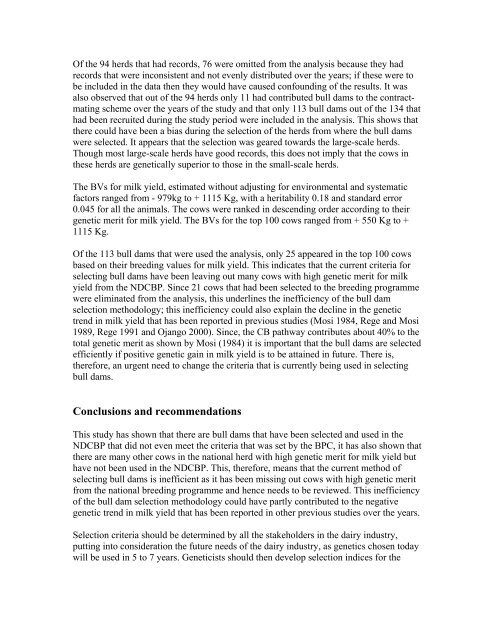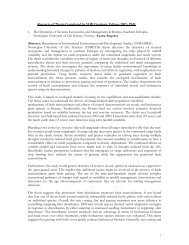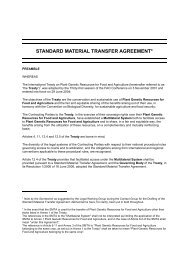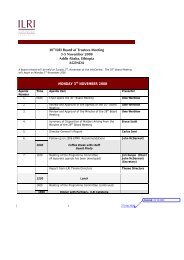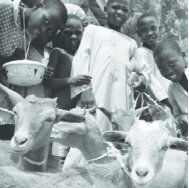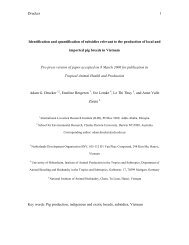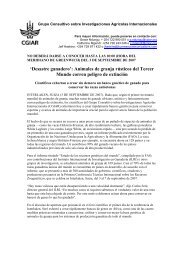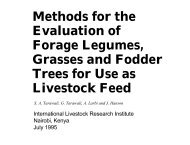An assessment of the efficiency of the dairy bull dam selection ...
An assessment of the efficiency of the dairy bull dam selection ...
An assessment of the efficiency of the dairy bull dam selection ...
You also want an ePaper? Increase the reach of your titles
YUMPU automatically turns print PDFs into web optimized ePapers that Google loves.
Of <strong>the</strong> 94 herds that had records, 76 were omitted from <strong>the</strong> analysis because <strong>the</strong>y had<br />
records that were inconsistent and not evenly distributed over <strong>the</strong> years; if <strong>the</strong>se were to<br />
be included in <strong>the</strong> data <strong>the</strong>n <strong>the</strong>y would have caused confounding <strong>of</strong> <strong>the</strong> results. It was<br />
also observed that out <strong>of</strong> <strong>the</strong> 94 herds only 11 had contributed <strong>bull</strong> <strong>dam</strong>s to <strong>the</strong> contractmating<br />
scheme over <strong>the</strong> years <strong>of</strong> <strong>the</strong> study and that only 113 <strong>bull</strong> <strong>dam</strong>s out <strong>of</strong> <strong>the</strong> 134 that<br />
had been recruited during <strong>the</strong> study period were included in <strong>the</strong> analysis. This shows that<br />
<strong>the</strong>re could have been a bias during <strong>the</strong> <strong>selection</strong> <strong>of</strong> <strong>the</strong> herds from where <strong>the</strong> <strong>bull</strong> <strong>dam</strong>s<br />
were selected. It appears that <strong>the</strong> <strong>selection</strong> was geared towards <strong>the</strong> large-scale herds.<br />
Though most large-scale herds have good records, this does not imply that <strong>the</strong> cows in<br />
<strong>the</strong>se herds are genetically superior to those in <strong>the</strong> small-scale herds.<br />
The BVs for milk yield, estimated without adjusting for environmental and systematic<br />
factors ranged from - 979kg to + 1115 Kg, with a heritability 0.18 and standard error<br />
0.045 for all <strong>the</strong> animals. The cows were ranked in descending order according to <strong>the</strong>ir<br />
genetic merit for milk yield. The BVs for <strong>the</strong> top 100 cows ranged from + 550 Kg to +<br />
1115 Kg.<br />
Of <strong>the</strong> 113 <strong>bull</strong> <strong>dam</strong>s that were used <strong>the</strong> analysis, only 25 appeared in <strong>the</strong> top 100 cows<br />
based on <strong>the</strong>ir breeding values for milk yield. This indicates that <strong>the</strong> current criteria for<br />
selecting <strong>bull</strong> <strong>dam</strong>s have been leaving out many cows with high genetic merit for milk<br />
yield from <strong>the</strong> NDCBP. Since 21 cows that had been selected to <strong>the</strong> breeding programme<br />
were eliminated from <strong>the</strong> analysis, this underlines <strong>the</strong> in<strong>efficiency</strong> <strong>of</strong> <strong>the</strong> <strong>bull</strong> <strong>dam</strong><br />
<strong>selection</strong> methodology; this in<strong>efficiency</strong> could also explain <strong>the</strong> decline in <strong>the</strong> genetic<br />
trend in milk yield that has been reported in previous studies (Mosi 1984, Rege and Mosi<br />
1989, Rege 1991 and Ojango 2000). Since, <strong>the</strong> CB pathway contributes about 40% to <strong>the</strong><br />
total genetic merit as shown by Mosi (1984) it is important that <strong>the</strong> <strong>bull</strong> <strong>dam</strong>s are selected<br />
efficiently if positive genetic gain in milk yield is to be attained in future. There is,<br />
<strong>the</strong>refore, an urgent need to change <strong>the</strong> criteria that is currently being used in selecting<br />
<strong>bull</strong> <strong>dam</strong>s.<br />
Conclusions and recommendations<br />
This study has shown that <strong>the</strong>re are <strong>bull</strong> <strong>dam</strong>s that have been selected and used in <strong>the</strong><br />
NDCBP that did not even meet <strong>the</strong> criteria that was set by <strong>the</strong> BPC, it has also shown that<br />
<strong>the</strong>re are many o<strong>the</strong>r cows in <strong>the</strong> national herd with high genetic merit for milk yield but<br />
have not been used in <strong>the</strong> NDCBP. This, <strong>the</strong>refore, means that <strong>the</strong> current method <strong>of</strong><br />
selecting <strong>bull</strong> <strong>dam</strong>s is inefficient as it has been missing out cows with high genetic merit<br />
from <strong>the</strong> national breeding programme and hence needs to be reviewed. This in<strong>efficiency</strong><br />
<strong>of</strong> <strong>the</strong> <strong>bull</strong> <strong>dam</strong> <strong>selection</strong> methodology could have partly contributed to <strong>the</strong> negative<br />
genetic trend in milk yield that has been reported in o<strong>the</strong>r previous studies over <strong>the</strong> years.<br />
Selection criteria should be determined by all <strong>the</strong> stakeholders in <strong>the</strong> <strong>dairy</strong> industry,<br />
putting into consideration <strong>the</strong> future needs <strong>of</strong> <strong>the</strong> <strong>dairy</strong> industry, as genetics chosen today<br />
will be used in 5 to 7 years. Geneticists should <strong>the</strong>n develop <strong>selection</strong> indices for <strong>the</strong>


